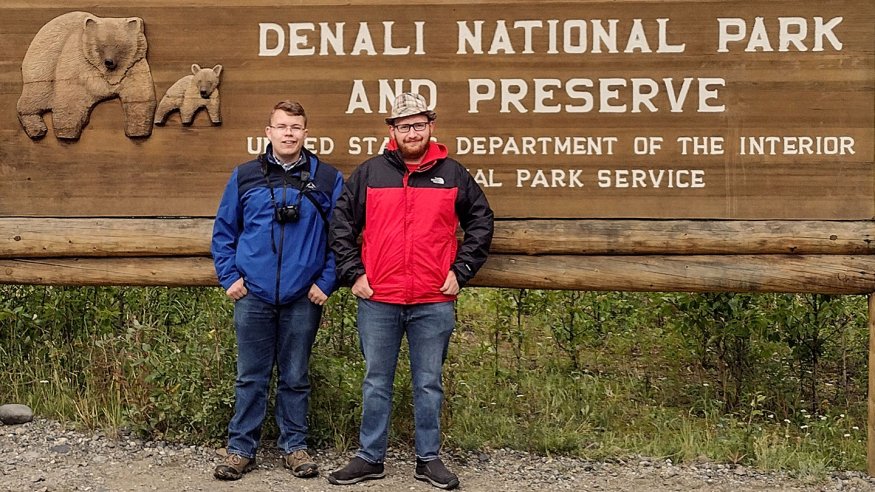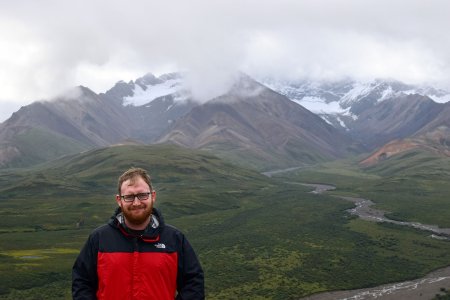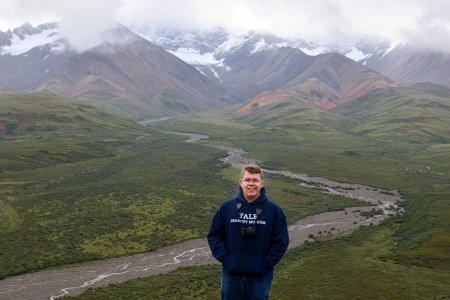
‘Defrosting Seward’s Icebox’
Ohio Wesleyan Students Visit Alaska to Study Climate Change Conversations


Name: Alan Cohn ’22
Hometown: Newton Falls, Ohio
Major: General Zoology
Minor: Psychology
Name: Josh Pletcher ’21
Hometown: Wellington, Colorado
Majors: Pre-Professional Zoology and Geology
Minor: History
OWU Connection Experience: Traveling to Alaska, supported by an OWU Connection grant, to study how the state is discussing environmental issues.
Josh Pletcher ’21 and Alan Cohn ’22 traveled to Seward, Anchorage, Denali, and Fairbanks, Alaska, for nearly two weeks in August to conduct original research titled “Defrosting Seward’s Icebox: Climate Change and Museums in Alaska.” Their project, supported by an OWU Connection Theory-to-Practice Grant (TPG) proposed by Pletcher, explored “how national parks, museums, and zoos in Alaska communicate climate change.”
Favorite Moments
Cohn: “The boat tour we did in Seward, Alaska, because on this tour of the Kenai Fjord, I saw a lot of marine species of animals. Animals like whales and sea otters that you would not be able in the main states. Even better, I got to see these animals in their natural wild habit.”
Pletcher: “I really enjoyed the boat tour of Kenai Fjords National Park in Seward, Alaska. It was very cool being able to see sea otters, seals, sea lions, porpoises, puffins, and humpback whales in their natural habitat, especially as I am from a landlocked state and don’t get to see marine life in the wild very often.
“It was also really neat to be able to visit the U.S. Army Corps of Engineers Permafrost Tunnel Research Facility outside Fairbanks, which is a one-of-its-kind facility that allows direct study of the permafrost in Alaska from underground. Inside the tunnel, there are frozen bones of bison and mammoths, as well as grasses from the Ice Age that are still green after 10,000 or so years, and fascinating ice formations.”
Plans and Procedures
Cohn: “One of the goals for this trip was to examine how a state like Alaska talked about climate change in their various museums and zoos, since they have a colder climate compared with the other states in the U.S.
“Another goal was to go to the University of Alaska: Fairbanks to look at grad school options and connect with their museum called The Museum of the North.
“Finally, a personal goal for me was to examine jobs at local zoos/wildlife centers and National parks to help guide my decision on what career option I would like to choose after college.”
Pletcher: “While in Alaska, (we) both kept daily journals of our experiences, recording what we saw and did and noting anything we found particularly interesting. This helped us to crystallize our thoughts and reflect on the day’s events.
“At each museum, zoo, national park, or tour we took, we used the forms we had made to evaluate how each discussed climate change, what the focus of the museum was, and aspects we liked or disliked about each place. These were helpful when we looked back to compare each institution and how it discussed climate change.”
Lessons Learned
Cohn: “One of the aspects I grew in was a deeper understanding of Alaska’s culture. You would think that Alaska was like any of the other 50th states in the U.S., but Alaska has a different atmosphere compared to other states I have been to in the U.S.
“On the trip, we took a lot of Lyfts/Ubers to get from place to place, and during these drives and other tours I talked a lot with Alaskan natives. From these talks, I learned that people stay in Alaska to get away from the social pressures found in the main states. From what I have seen, Alaskans see themselves as different from individuals from the other states.”
Pletcher: “Academically, this TPG experience has allowed me to apply what I have learned in class, in particular classes such as Ornithology, to the real world. The information I learned in Ornithology was particularly applicable when we visited the Alaska SeaLife Center in Seward and the Potter’s Marsh Bird Sanctuary, where I was able to identify several species of bird and watch for their distinctive behaviors.
“Visiting the University of Alaska Fairbanks to meet with professors and explore the collections was very useful for me as I start the process of applying to graduate schools. … Professionally, this trip was very useful to me in my work in our Natural History Museum on campus, especially when we visited the University of Alaska Fairbanks. ...
“Personally, one thing I gained from this trip was experience planning and coordinating a trip such as this. Preparing a detailed budget and accounting our expenses while traveling was also a useful skill I gained. Another thing I learned on this trip was how to be flexible while traveling and make the most out of what we are able to experience. I also learned a lot by chatting with Alaskans about life in Alaska.
“Intellectually, visiting Alaska sparked my curiosity even more about Alaska’s natural history, and I would love to visit again to explore more off the beaten path.”
Why Ohio Wesleyan?
Cohn: “I searched for local colleges in Ohio that had Zoology programs, I applied to most of these colleges, and I got accepted to OWU with a nice scholarship. I also decided to go to OWU because of its small class sizes and close interaction with professors. These factors were helpful to me since I have dyslexia, so the small class sizes helped accommodate my disabilities better than colleges with huge class sizes.”
Pletcher: “I chose to attend Ohio Wesleyan because of the opportunities to work in the Natural History Museum; the travel opportunities, such as the Travel-Learning Course ‘Biology of East Africa’; Theory-to-Practice Grants, and Small Program Grants.” (Travel-Learning Courses and both of the University-funded grants are part of The OWU Connection.)
Post-Graduation Plans
Cohn: “I want to get a career that involves animal care in a zoo or aquarium. I also would like to get back into hobbies that I didn’t have much time to do in college, like painting.”
Pletcher: “After graduation I plan to explore graduate school opportunities in Zoology and Paleontology and will continue writing the history of Ohio Wesleyan’s Natural History Museum that I have been working on over the course of this semester.”
